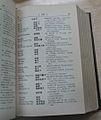Fuzhou dialect facts for kids
The Fuzhou dialect is a special way of speaking that comes from the Mindong language family. It's different from the Minnan dialect, and fewer people speak Fuzhou dialect today. This is partly because the areas where these languages grew had different ways of life. For example, the Fuzhou area was mostly about farming, while southern Fujian had a lot of fishing.
Today, the Fuzhou dialect is spoken in seven counties around Fuzhou in eastern Fujian province, as well as in Ningde City and Nanping City. You can also hear it in places like Taiwan, Indonesia, Thailand, Brunei, and Singapore. Because many people from Fuzhou have moved around the world, the dialect is also spoken in Chinese communities in North America, South America, Europe, and Australia.
Contents
How the Fuzhou Dialect Developed
The Fuzhou dialect has a long history, coming from ancient and medieval Chinese languages. Over many years, different groups of people moved into the Fujian area. As they settled, their languages mixed together, slowly forming what we now know as the Fuzhou dialect. It has changed quite a bit in how it sounds and the words it uses, especially over the last 200 years.
Early Influences on the Language
Long ago, a group of people called the Yue people lived near the Li River. When the Chu kingdom was destroyed, some people from that kingdom moved to Fujian. They joined with the Yue people, forming a new group.
Later, around 110 BC, the Yue dynasty fought against the Han dynasty. The Han emperor, Emperor Wu of Han, won, and many Yue people were moved to other areas. During the Western Han Dynasty, people from the Central Plains (the main part of China) came to Fujian for the first time. Their language mixed with the local Yue languages, adding to the Fuzhou dialect.
More People Arrive and Language Changes
During the Jin Dynasty, more people from the Central Plains moved to Fujian. This led to even more mixing between the Han people and the Yue people. The Han people became the main residents of Fuzhou, and their Central Plains language further shaped the Fuzhou dialect.
Towards the end of the Tang Dynasty, another large group of Han people from the Central Plains arrived. This time, a leader named Wang tried to create a new kingdom. This led to even more mixing of languages, including the Gan dialect. By the Tang Dynasty, the Fuzhou dialect had largely taken its current form and continued to develop.
Efforts to Keep the Fuzhou Dialect Alive
In recent times, the push to speak Mandarin Chinese (the official language of China) has meant that fewer and fewer young people are learning Fuzhou dialect. However, people in the government and local communities have noticed this problem. They are now working hard to encourage people to speak and learn Fuzhou dialect. Studies show that about half of young people in Fuzhou today can speak the dialect.
Books and Studies on the Dialect
The very first book about how to pronounce Fuzhou dialect was called Qī Lín Bāyīn (or 'Yulin Sounds'). It was published in the 17th century and helped set a standard for the dialect.
In the 1800s and 1900s, scholars from Western countries became interested in the Fuzhou dialect. They wrote dictionaries and even translated the Bible into Fuzhou dialect. Japanese scholars also published books about the dialect in the 1940s. Thanks to these efforts, a way to write Fuzhou dialect using the Latin alphabet was created and standardized in 1890. This writing system was mainly used in churches.
Images for kids
-
Japanese-Chinese Translation: Fuzhou Dialect, published in Taipei, 1940. Foochow kana is used to represent Foochow pronunciation.
-
Pupils in Gulou Experimental Elementary School (鼓樓實驗小學) in Fuzhou are learning the Foochow nursery rhyme Cĭng-cēu-giāng (真鳥囝)
-
Bible in Foochow Romanized, published by British and Foreign Bible Society in 1908.
See also
 In Spanish: Dialecto fuzhou para niños
In Spanish: Dialecto fuzhou para niños







